How to Create Salon Website in 2024
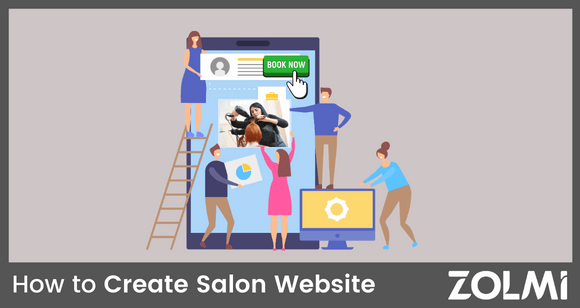

One of the most important things that salon owners can do is create a salon website that reflects your unique salon brand and makes it easy for clients to find you. Let’s take a look at the different options available.
We’ll go over what you need to know to make an informed decision between using a modern salon website builder and an agency, plus the process and cost of creating a business website.
If you’ve been inspired by other salon websites and are ready to launch your own, you may be wondering whether it’s better to do the work yourself using a salon website template or hire a web design agency to help you with this.
They both have their advantages and disadvantages, and a lot of it comes down to how much research you’re willing to put in and the extent of your own professional experience.
Let’s take a look at the pros and cons of each approach:
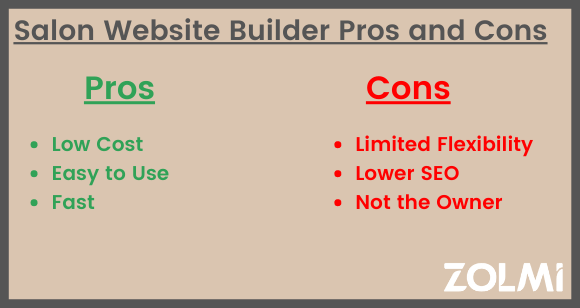
This is a DIY approach that lets you build your own salon site without needing any coding skills or web design skills. You can choose a site builder that meets your salon business needs, then add all of the important details to their website templates.
They provide the ready-made hair salon website template for you to work with, and you simply insert the text that you want, then drag and drop everything into the new website layout.
Pros:
Low Cost: making your own website is cheaper than hiring a professional, and the subscriptions to these services are usually very affordable.
Easy to Use: these website templates have a very user-friendly interface, and you can integrate it with your salon software and social media accounts quickly.
Fast: you can create your website quickly if you’re eager to reach potential customers (think overnight, if needed), whereas working with a professional web designer takes more time. You can also use the website editor to make quick changes later, if needed.
Cons:
Limited Flexibility: using a website template means that you may not be able to do everything that your creative side wants to do, which can be frustrating if you have something specific in mind.
Lower SEO: unless you’re familiar with coding, you’ll have to rely on the company’s template, which means that you can’t add SEO tags and terms. This will limit your ability to reach potential clients through Google and other search engines.
Not the Owner: you won’t own the code used to make the site’s content, and it’s likely that your new website won’t work without the website builder’s software. You’ll also probably have to deal with advertisements if you’re using a free salon website builder.
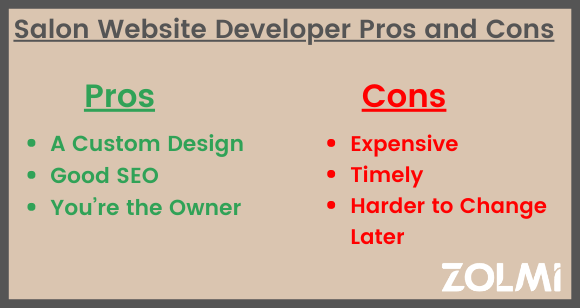
If you decide to hire an experienced professional website developer, you’ll most likely get what you’re paying for- customized, professional-looking results and personalized attention. After all, it’s their job to listen to a client’s needs and create professional websites that look good.
Just make sure that you choose someone experienced, whose style you like. It’s always a good idea to ask for some examples, check out their portfolio and read client reviews before hiring them.
Pros:
A Custom Design: they’ll consult with you and create a website tailored to your salon’s needs, with the features that you want.
Good SEO: these professionals are familiar with search engines like Google, understand the importance of SEO tags and will make sure to optimize your site’s functionality to rank higher on search engine results.
You’re the Owner: you own the domain name and are free to change the site’s coding later on or move it to another server without having to worry about starting over from scratch with another template.
Cons:
Expensive: hiring a professional to perform any services just costs more than doing it yourself, which could be a problem if you’re on a budget or just getting started.
Timely: a professional web developer is going to need more time to learn about your salon’s needs, program the website and get everything just right for you. If their services are in demand, they might even have a waiting list of clients already.
Harder to Change Later: remember what we said about coding? If you want to change any of your website’s features or add new ones, you’ll probably need to hire someone to help with this, since you’re building a website and not using a premade template.
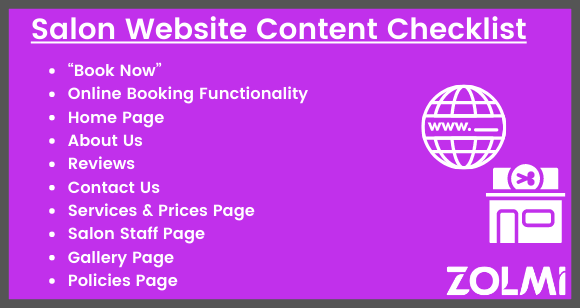
Checking out your hair salon’s website is likely to be the first interaction that potential clients have with your business, so it’s got to make a great impression on them.
A lackluster or clunky hair salon website design might underwhelm or confuse them, meaning that they won’t book appointments with you.
But how do you go about building a stunning website for your salon?
We can’t tell you exactly what your brand aesthetic should be, but we have put together this step by step guide on how to create a website that’s perfect for your salon.
Choose something that’s easy to remember, unique, relevant and above all… Available!
Make sure that your domain name is tied to your salon’s name, so that clients will make the connection.
Keep everything consistent online to avoid confusion by sticking with domain names that are similar or related to your FaceBook, Instagram, and Ticktock page names.
Consider your budget- can you afford to hire a professional developer or is it better to use inexpensive or free website editor templates?
Think about your salon’s needs- do you want to showcase a lot of photos of stylists’ work, are your clients likely to use an online booking feature, and do you want to sell retail products online, etc.?
Consider using salon software with a website builder to get the most out of your business and optimize everything at once. This is a great, user-friendly option for salon owners looking to save both time and money.
Use a template, but create salon website features that pop by adding your own special touches (especially when working on marketplace websites)
Research Salon Websites for Inspiration- checking out hair salon website examples online to see what each business is doing right can help give you an idea of what you want out of your own site.
Check out our Hair Salon Website Awards competition results for some great examples!
Make Your Website Reflect Your Salon Brand
Make sure to use your salon brand’s color scheme.
Choose/play with fonts (but not too many)- try to stick with three different fonts, max. You can use bold text and italics to distinguish between headers, text and highlights, if necessary.
Add /Design your salon logo- you’ll need something that sets your salon apart and is easy for clients to remember.
Add Images and Videos- try to capture the originality and feel of your salon brand. Having high-quality pictures and videos of your team that show off their skills will make a huge difference in your online marketing.
Resist the temptation to rely on stock photos. Consider hiring a professional photographer for staff portraits and interior shots of the salon.
Make It Mobile Friendly and Fast- most clients will look at your salon website on their mobile devices, so you’ll want a mobile version that’s easy to use and loads quickly.
Put Clarity and Usability Over Visuals- if your salon’s website has a lot of pictures and looks great but is confusing or hard to navigate, potential clients will get frustrated.
Work on the right structure for your website and make sure that it’s got everything your clients need within easy reach.
“Book Now” with a Clear Call to Action Button- give people the option to book an appointment for services as soon as they visit the page. This is key for getting more business. No scrolling or trying to figure out how to do it, just a user-friendly button that takes them directly to the Booking Page.
Online Booking Functionality- make online bookings easy with 24/7 live booking and the ability to process payments, take deposits and even order products online.
Home Page- this is your salon’s first impression (so make it a great one). Use a header image, some short text- no more than 100 words, and a navigation panel. The text should be accessible for visitors without having to scroll the page.
About Us- the “Who.” Introduce your salon’s story, mission statement, values, staff and everything else that makes your salon special.
Reviews- the “Why.” Include customer testimonials about your business, staff and services, and maybe even a link to your Google my Business reviews.
Contact Us- the “When” and “Where.” Make it easy to get in touch by providing your salon’s location, directions, contact details and business hours on your contact page.
Services & Prices Page- include the names of your salon’s services, a short description, the duration and prices.
Salon Staff Page- Make your team shine by using professional images and a description (you might ask them to write a short introduction with some personal details such as hobbies, too). This will appeal to new clients.
Gallery Page- include salon photos and photos that show off a variety of your staff’s work to win over new clients and inspire them to book.
Policies Page- this needs to include your salon’s booking, cancellation and privacy policies for easy reference.
Search Engine Visibility- you should care about your salon’s search engine optimization (SEO) and local SEO because these have a big impact on how easy it is to find your business online.
If you’re working with a developer, they can add tags to help with search engine optimization during the programming process.
Use Google My Business and promote your salon on social media. Make sure that you have a FaceBook, Instagram or TickTok page set up and link them to your salon’s website.
Add new clients to your FaceBook page and salon email marketing list or salon newsletter.
Promote Your Personal Brand- post frequently online, update your salon’s social media pages frequently and add new content to keep reaching new clients.
Do not miss our post on Hair Salon Web Design Checklist, it will help you organize the process of creating your salon website.
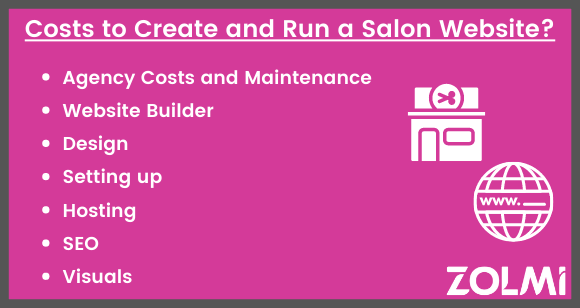
Multiple factors can impact how much it costs to get your salon’s website up and running. Some of these are one-time costs (like hiring a professional to design and build the site), and some are recurring (like renting a domain name). Let’s take a look at each one in more detail:
Agency Costs and Maintenance- hiring a professional web design agency can cost you $15,000 or more, depending on the level of detail and work involved in building your salon’s website. Routine site maintenance can start at about $35 a month, but can also get much more expensive, depending on what’s needed.
Website Builder- these are cheaper since you’re doing most of the work yourself. Ones with ads on them can be free, but if you want to buy access to an ad-free one, it’s typically just a few hundred dollars.
Design- web designers usually charge a lot for their time. Expect to pay at least $75 per hour for a professional’s services.
Setting up- this can include everything from finding the right web designer (or doing it yourself), to putting in the time and research to find out what your target demographic is if you’re just starting out as a salon.
Hosting- shared hosting can cost only a few dollars a month, and is okay for websites without a lot of traffic. Paying for a dedicated server (the fastest and most expensive option) can cost a lot more, with plans starting at over $100 a month.
SEO- some businesses spend over $500 a month keeping their SEO services up to date, but the initial cost of adding SEO tags can usually be bundled into the overall fee that a website developer charges when they set everything up.
Visuals- this includes hiring a graphic designer to create your salon’s logo and a photographer to take and photos for the site. Make sure to shop around and see what’s available in your area and get multiple price quotes before deciding on one.
In today’s fast-paced and digital world, opening a hair salon means establishing an online presence. This is true for salon owners with brick and mortar businesses, too- if you don’t already have a website for your salon, it’s more important than ever that you get one.
Having a website for your salon business will help you to expand your client base, take online bookings and communicate easily with existing clients.
It can be challenging to create a salon website that both looks great and does everything that you need it to do, but with a little time and effort) and maybe some help from a professional, you’ll be ready to go.
Key website factors in e-business strategy
https://www.sciencedirect.com/science/article/pii/S0268401209000024
Exploring website features for business information
https://akjournals.com/view/journals/11192/61/3/article-p467.xml
Marketing decisions, customer reviews, and business performance: The use of the Toprural website by Spanish rural lodging establishments
https://www.sciencedirect.com/science/article/pii/S0261517714000648